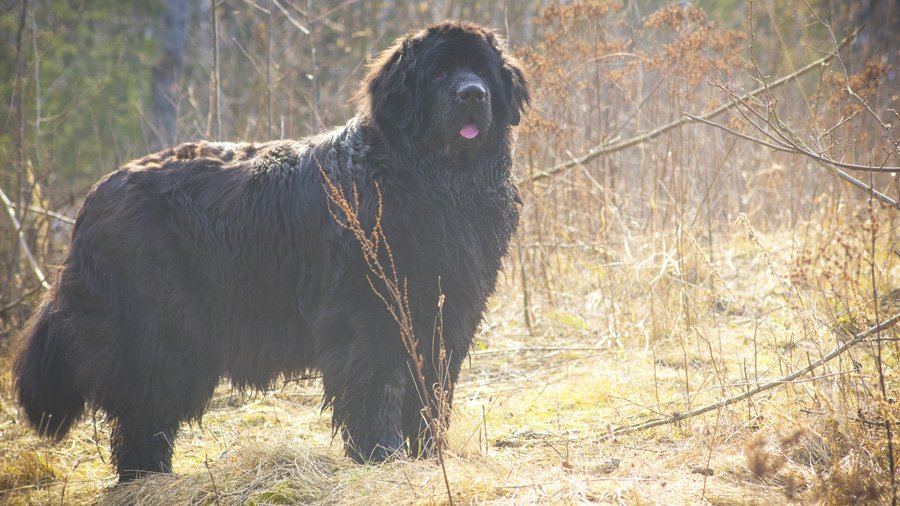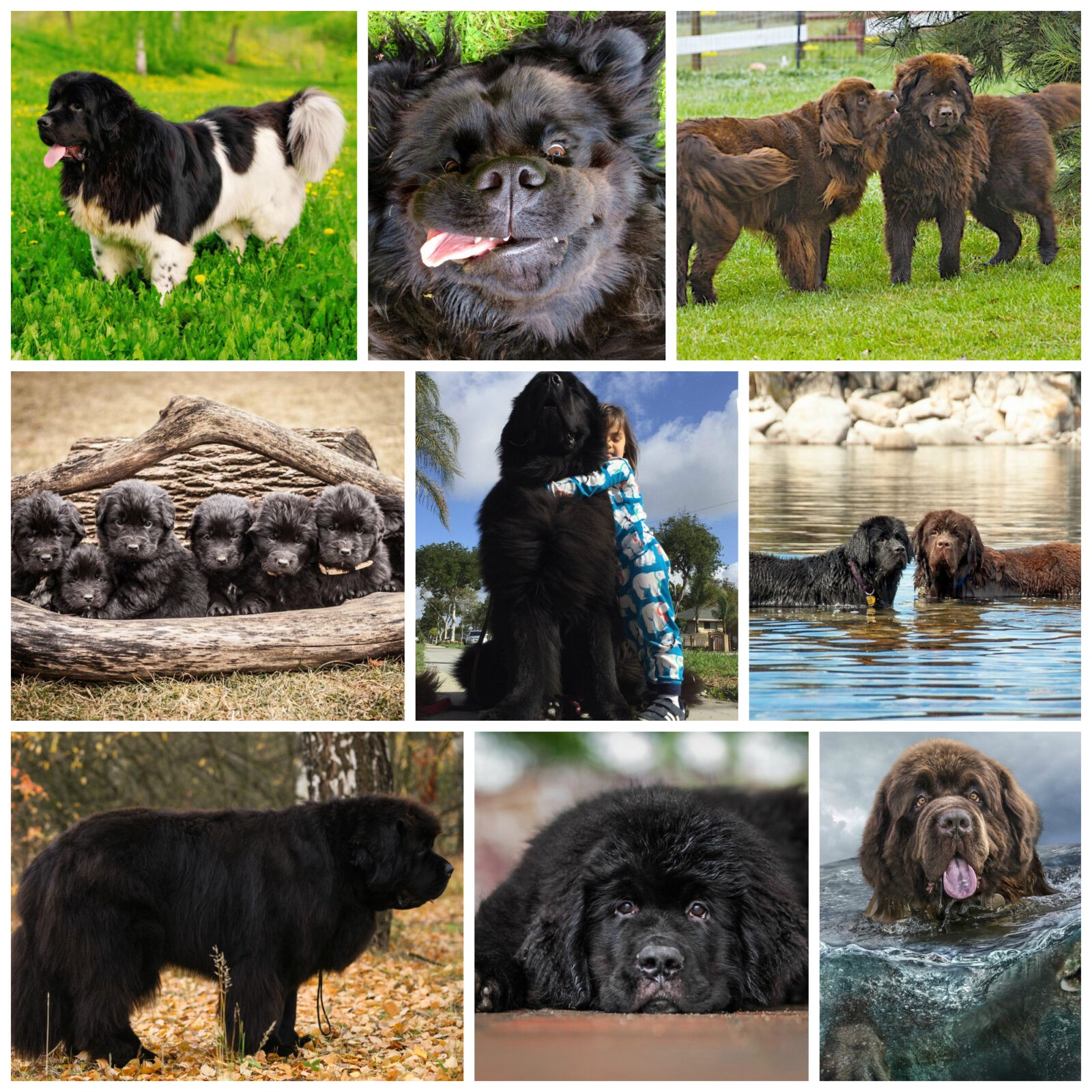Ньюфаундленд — это гигантская, но нежная, смелая и умная собака, которая отличается своим послушанием и безграничной любовью к детям. Она станет отличным питомцем для любой семьи.

Краткое описание породы
Наверное, самым известным ньюфаундлендом является герой детского произведения «Питер Пэн». Хотя персонаж и вымышленный, но он отлично иллюстрирует любовь этой породы к детям.
Ньюфаундленд обожает воду, об этом напоминают и его перепонки между пальцами. Именно это повлияло на то, что собаки этой породы часто выполняют обязанности спасателей на воде. Сегодня же ньюфаундленд — это, прежде всего, собака — компаньон. Она имеет множество положительных качеств, но гигантские размеры животного указывают на то, что питомец может столкнуться с различными заболеваниями. Это необходимо учитывать, принимая решение о приобретении такой собаки.
Ньюфаундленд — спокойное, милое и дружелюбное животное, особенно в отношении детей. При этом собака готова постоять как за себя, так и за своего хозяина. Несмотря на то, что эту породу нельзя отнести к активным, тем ни менее, ньюфаундленд обожает плавать и играться в воде. Именно это стало причиной того, что собаки этой породы являются постоянными участниками спортивных состязаний собак на воде.
Помимо прочего, ньюфаундленды станут отличными спутниками в любых путешествиях и походах, из-за этого многие туристы и путешественники становятся счастливыми владельцами этих милых великанов.
Вес взрослой собаки может достигать 50–75 килограммов! Это говорит о том, что у собаки могут развиваться патологии опорно-двигательного аппарата, что приводит к сокращению жизни животного. Правда случается это в основном у нерадивых собаководов.
Как и любая собака, ньюфаундленд нуждается в ранней социализации. В противном случае животное может быть замкнутым и проявлять агрессивность к незнакомым и гостям. Для тех, кто не уверен в своих воспитательных способностях, специалисты рекомендуют отдать собаку в специальный класс для собак, где с вашим питомцем будут заниматься специалисты.
Как и другие щенки, ньюфаундленды любят играть, но в виду своих размеров они могут наносить ущерб имуществу хозяина, к примеру, предметам декора и интерьера. Это еще одно доказательство того, что щенки этой породы нуждаются в раннем обучении и социализации, ну и, естественно, в большом количестве внимания.
Начинать обучение необходимо с первого дня появления щенка в доме. В этом возрасте собака полностью управляема и максимально склонна к обучению. В процессе дрессировок не забывайте использовать основополагающие принципы похвалы и вознаграждения! Если вы планируете обучать питомца упражнениям на воде, то производить такое обучение необходимо под строгим контролем, лучше всего, конечно же, обратиться к профессиональному тренеру.
Ньюфаундленд — это та собака, которая обязывает вас иметь надежное ограждение во дворе. Правда это не означает, что питомца можно содержать непосредственно во дворе или в вольере. Ваш домашний любимец должен проживать с вами под одной крышей!
Еще один важный момент, который должен знать каждый владелец ньюфаундленда, заключается в физических упражнениях в первые два года жизни. В этот период скелет собаки проходит активную фазу формирования, а значит необходимо сократить тяжелые физические нагрузки, которые могут оказать пагубное влияние на развитие хребта и опорно-двигательного аппарата в целом. В этот период будет достаточно занятий на воде, прогулок на свежем воздухе. При этом ограничивайте нагрузку во время пробежек. Такие ограничения обязательны до достижения питомцем двухлетнего возраста.
Основная информация
| Название породы: | Ньюфаундленд |
| Страна происхождения: | Канада |
| Время зарождения породы: | неизвестно |
| Тип: | молоссы |
| Вес: | 50 – 75 кг |
| Рост (высота в холке): | 66 – 71 см |
| Продолжительность жизни: | 8 – 10 лет |
|
Классификация МКФ:
|
Группа 2, Секция 2, Номер 50 |
| Цена щенков: | 250 – 1100 $ |
| Самые популярные клички: | список кличек для ньюфаундленда |
Оценка характеристик породы Ньюфаундленд
| Адаптивность
(определение, означающее, насколько легко собака может приспосабливаться к изменениям в жизни) |
🐶🐶🐶🐶 |
| Уровень линьки
(Уровень и частота выпадения волос у животного) |
🐶🐶🐶🐶🐶 |
| Уровень нежности
(Уровень и количество нежности и ласки, которую собака отдает взамен на внимание к себе) |
🐶🐶🐶🐶 |
| Потребности в упражнениях
(Уровень дневной активности собаки) |
🐶🐶🐶 |
| Социальная потребность
(Необходимое количество контактов собаки с другими животными, а также людьми) |
🐶🐶🐶🐶 |
| Квартирное содержание
(Фактор, определяющий уровень шума и иных неудобств, которые собака может доставлять хозяевам в соотношении размера квартиры к размеру собаки) |
🐶🐶🐶 |
| Груминг
(Количество купаний, расчесываний, а также необходимое количество сеансов профессионального груминга, необходимого собаке) |
🐶🐶🐶🐶🐶 |
| Дружелюбность в незнакомой среде
(Особенности поведения собаки в обществе с незнакомыми людьми или в незнакомой обстановке) |
🐶🐶🐶🐶 |
| Тенденция к лаю
(Склонность к лаю и его частоте и громкости) |
🐶🐶🐶 |
| Вопросы здоровья
(Потенциальный уровень состояния здоровья собаки) |
🐶🐶🐶🐶🐶 |
| Территориальность
(Склонность собаки к защите своего дома, двора или даже автомобиля хозяина) |
🐶🐶🐶🐶🐶 |
| Дружелюбность к котам
(Тенденция к терпимости к кошкам и пониженное проявление охотничьих инстинктов) |
🐶🐶🐶🐶🐶 |
| Интеллект
(Способность собаки к мышлению и решению возникающих трудностей (не стоит путать с обучаемостью!) |
🐶🐶🐶🐶 |
| Воспитание и дрессировка
(Уровень сложности в обучении собаки выполнять определенные действия) |
🐶🐶🐶 |
| Дружелюбность к детям
(Фактор, определяющий насколько собака дружелюбна к детям, любит ли она с ними играть и терпеть некоторые детские шалости) |
🐶🐶🐶🐶🐶 |
| Игровая активность
(Понятие определяется самим его названием, и, как правило, встречается почти у всех собак) |
🐶🐶🐶 |
| Наблюдательность
(Способность собаки определить присутствие чужого на своей территории) |
🐶🐶🐶🐶🐶 |
| Дружелюбность к другим собакам
(Склонность собаки находить общий язык с другими своими сородичами) |
🐶🐶🐶🐶 |
Ньюфаундленд фото:

История происхождения
История происхождения породы, в большей своей части, является предположением, так как сохранилось мало достоверных фактов о появлении и развитии ньюфаундленда. По одной из версий, ньюфаундленд появился в Пиренеях, откуда позже рыбаки завезли эту породу в Ньюфаундленд.
По другим версиям, истоки породы берут начало во Франции или в странах Скандинавии. Единственное, что известно точно, это то, что активная селекция породы началась на канадском острове с одноименным названием — Ньюфаундленд. На острове собака была верным помощником рыбаков, что и повлияло на развитие у собак любви к воде. Постоянное нахождение у воды объясняет наличие у животного густой, практически водонепроницаемой шерсти, перепонок между пальцами. Ньюфаундленды помогали передвигать тяжелые рыболовецкие грузы, спасали тонущих во время кораблекрушений, вытаскивали детей из воды.
Позже порода попала в Англию, где она стала очень популярной. Упоминания об этой породе встречаются даже в произведениях Лорда Байрона.
Порода ньюфаундленд по праву заслужила звание спасателя тонущих. По истории, рассказанной одним из спасенных пассажиров Титаника, ньюфаундленд, который был на корабле вместе со своим хозяином, прыгнул в воду и плыл у шлюпки хозяина до тех пора, пока на помощь ни пришел пароход Карпатия. Так или иначе, собаки этой породы — по истине удивительны.
Характер ньюфаундленда
Ньюфаундленд известен своим интеллектом, верностью и нежностью. Несмотря на то, что эта порода относится к сторожевым породам, ньюфаундленд — отличная семейная собака. Питомец с удовольствие будет проводить время с хозяином.
Помимо прочего, ньюфаундленд — это настоящий помощник для родителей. Собака может следить за детьми у водоема или простого бассейна. Это, конечно же, не означает, что детей можно бросать без присмотра и надеяться лишь на животное.
Порой, при недостаточном воспитании, ньюфаундленды могут проявлять нехорошие привычки: копание, лай и т.д. Случается это также в тех случаях, когда животному скучно. Обратите внимание, что подобное поведение можно считать нормой в «подростковом возрасте» (с шести месяцев до года), но не стоит позволять это делать животному.
Содержание и уход
Ньюфаундленд является обладателем водонепроницаемого подшерстка коричневого, черного или серого цвета. Поэтому необходимо пару раз в неделю тщательно вычесывать шерсть металлической щеткой. Это поможет предотвратить образование катышей и позволит своевременно удалять отмершие волосы. Регулярное расчесывание также предупредит распространение волос питомца по дому.
Ньюфаундленды активно линяют два раза в год – весной и осенью. В этот период необходимо чаще вычесывать шерсть. Собаки этой породы склонны к обильному выделению слюны. Владельцу ньюфаундленда придется носить с собой салфетку для того, чтобы своевременно вытирать рот собаки. Купают этих собак по мере необходимости.
Остальной уход заключается в процедурах, являющихся общими для большинства пород. Когти подстригают, как правило, раз в две недели. Чистить зубы нужно каждую неделю специальной зубной пастой. Также нужно следить, чтобы уши ньюфаундленда были сухими, ведь эти собаки очень любят воду.
Дрессировка и обучение
Здоровье и болезни
Несколько интересных фактов
- Ньюфаундленд — отличный спасатель, он способен спасти жизнь взрослому.
- Ньюфаундленд склонен к обильному выделению слюны.
- Изначально ньюфаундлендов выводили для помощи перемещения грузов на рыболовецких судах. Сегодня же собаки этой породы активно используются в качестве собак-спасателей на воде, именно из-за этого ньюфаундленды инстинктивно прыгают в воду, когда видят тонущего человека.
Питомники и заводчики
Материал мы заимствовали с замечательного сайта наших партнеров DOGCATFAN.COM о кошках и собаках, автор dogcatfan
